Affiliate Disclaimer
As an Amazon Associate I earn from qualifying purchases. It helps me keep the website going. Thank you for your support.
In order to survive in the wild, horses had to evolve to care for themselves. Just as they maintain their own hooves and coats, wild horses float their teeth too. Horses evolved special characteristics to enable them to survive in the wild. When horses were domesticated, humans had to invent ways to provide care that mimicked how wild horses cared for themselves.
Wild horses float their teeth in a similar way to how they maintain their own hooves. They float their own teeth as they graze each day. The teeth wear down due to the tough grass, bushes, and bark that wild horses eat. Domestic horses need to have their teeth floated by a dentist, as they do not eat the same abrasive foods.
‘Teeth floating’ is a standard part of caring for a horse. Whether a horse is wild or not, having healthy teeth is vital to their health and well-being. Read on to learn more about equine teeth and how to care for them!
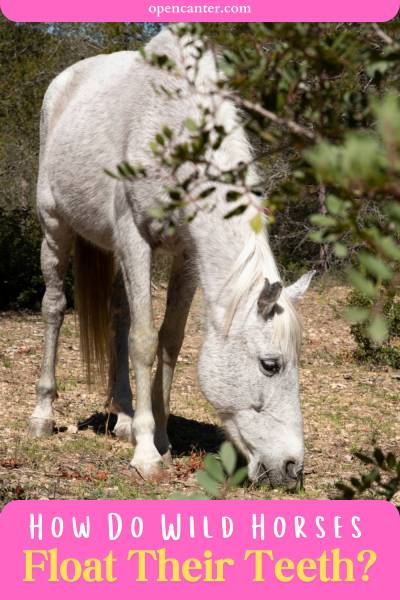
What is ‘Teeth Floating’?
The term ‘teeth floating’ refers to the natural wearing down of a horse’s teeth. As horses chew, they use a circular grinding motion. Over time, this naturally wears down the horse’s teeth.
Modern equine terminology has adopted the term ‘teeth floating’ to refer to equine dentistry. To most horse people, teeth floating is the process used to file down sharp teeth. The file used for the job is also commonly referred to as a float.
Teeth floating, when done correctly, does not hurt the horse. If too much of the tooth is worn or filed away, the nerves within the tooth are exposed. This causes pain until the tooth erupts back out to normal levels.
However, a lack of floating can be just as harmful. This causes the teeth to become too long, which makes it hard for the horse to chew. This can accelerate the development of sharp points and other dental issues.
Teeth floating is also an essential part of caring for the ridden horse. The use of halters, bits, and bridles can become painful if the horse has dental problems. This can result in issues from poor performance through to rearing and being hard to stop and steer.
Wild horses float their teeth naturally every day when they eat. Their diet is consistently made up of very tough food, which needs lots of chewing. Comparatively, the domestic horse has much softer feed. They don’t require anywhere near as much effort or range of motion to chew.
Hence, this is where the modern example of tooth floating comes in. Domestic horses need human help to be able to manage their teeth. Equine dentists are specialists that are able to identify and fix any teeth that have become sharp or too long.
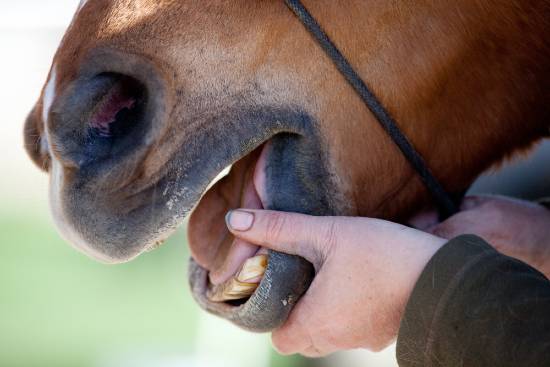
Structure of Equine Teeth
Let’s take a brief look at the structure of equine teeth. This will help you understand some of the issues that can affect a horse’s teeth, and how to prevent them.
There are four main parts to a horse’s tooth:
- Pulp: this is the innermost part of the tooth. It has vital structures like blood vessels and nerves. The pulp is not too far from the surface of the tooth. If the teeth are filed or worn down too much, the nerves are painfully exposed.
- Dentin: this makes up most of the tooth. It forms part of the surface of the tooth. Dentin protects the pulp and contributes to forming the rough grinding surface of the teeth.
- Enamel: this is the tooth’s hardest substance and is what forms the ridges on the chewing surface of the teeth.
- Cementum: this is the outermost layer of the tooth. It is very similar to bone and works as an attachment between the tooth and periodontal ligament. (source)
Horses have two main types of teeth: incisors and molars. The incisors are the teeth at the front of the mouth, and the molars are the cheek teeth. The incisors are responsible for biting and tearing off food. The molars are responsible for grinding and chewing food. In most cases, it is the molars that are affected by uneven wear patterns.
Each tooth is held in place by a ligament called the periodontal ligament. This ligament connects the tooth to the bone of the jaw. If this ligament is damaged, the teeth become wobbly or fall out.
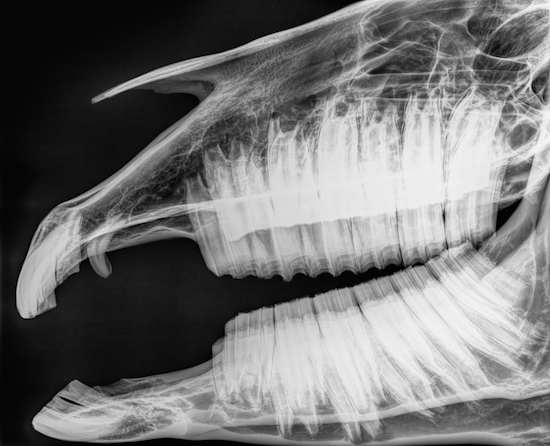
How do Wild Horses Float Their Teeth?
Horses evolved to have teeth that constantly erupt to cope with their diet. A wild horse’s diet consisted of very tough and fibrous grasses, bushes, and bark. These plants required extensive chewing to extract nutrients and to be able to be swallowed. You can read more about what horses eat in the wild here.
The amount of chewing that is required to eat this sort of diet causes a lot of wear on teeth. This is why horses evolved to have teeth that constantly erupt. Their teeth are designed to withstand large amounts of wear to support a longer life.
Horses also developed a unique way of chewing. They use a circular grinding motion, rather than an up-and-down chewing motion. This helped them break down tough plants so that they could be swallowed. This grinding motion also contributes to the amount of tooth wear.
As the wild horse grazes, they will eat a variety of different plants. Generally, lush grazing is sparse, and the wild horse spends a lot of time chewing. Because their food is harder to chew, they will use the full range of their chewing motion.
This means that all their teeth are subject to wear – unlike the domestic horse. Wild horses also travel further each day. This means that they need to eat more food than the horse who doesn’t get as much exercise. This results in more chewing!

Why do We Float Horse’s Teeth?
A horse’s top jaw is naturally narrower than their bottom jaw. As such, their top and bottom molars do not line up perfectly. This can mean that the outside edge of the top molars, and the inside edge of the bottom molars, can become sharp.
These sharp edges can cause discomfort or pain if they are not filed down. They can even cause cuts inside the mouth! This is where teeth floating comes in – the sharp points of the teeth are filed down manually.
If the horse uses the full range of their chewing motion, it is unlikely that they will develop sharp points. This is because all of their teeth are subject to wear caused by grinding and chewing.
Domestic horses do not have anywhere near as abrasive a diet as wild horses. These horses eat mostly hay and soft grasses. These types of food do not take anywhere near as much effort to chew. This means that the teeth are not worn down as fast as they erupt. This can cause the teeth to become too long.
It also means the likelihood of developing sharp edges is much higher. This is because the horse is not eating anything that requires a great amount of chewing. The horse doesn’t need to use the full range of grinding motion to chew, resulting in larger sections that remain unworn.
Most domestic horses also receive a concentrate feed. Mostly, these feeds are soaked or cooked in some way – meaning that they barely require any chewing. This results in little to no wear to the horse’s teeth.
If the horse is fed large amounts of soft foods, they might not chew with a grinding motion at all. Instead, because the food is so soft, they chew with an up-and-down motion like humans.
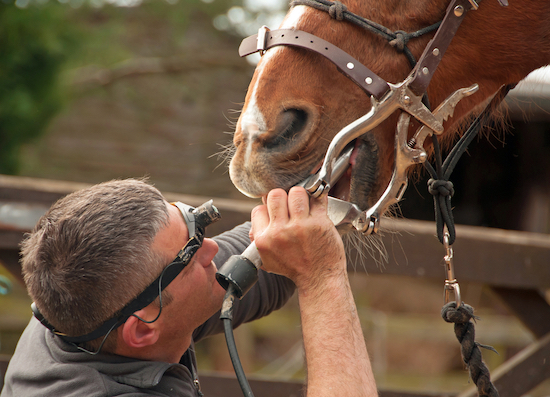
What Happens When Wild Horses Don’t Float Their Teeth?
Put simply, wild horses that could not float their teeth would die a premature death. Poorly maintained teeth cause pain and difficulty eating. This means the wild horse would not be able to get enough nutrients to survive.
Wild horses with poor teeth usually slowly starve to death. While they can still eat some food, they are unable to eat the amount required to stay healthy. Additionally, being unable to chew properly means the horse is unable to get as much nutrition out of the food.
Being unable to chew properly can also cause other issues like choke and colic. Both of these issues can become life-threatening if they are not treated. In the case of wild horses, unless these issues resolve themselves, they are deadly.
Choke and Colic in Wild Horses
Choke occurs when a ball of feed gets stuck in the horse’s esophagus. If the horse is not chewing their feed properly, there is a much higher risk of the feed becoming stuck. This is because it is simply not chewed up enough to be swallowed smoothly.
Choke is not an immediately life-threatening issue. Unlike humans, horses can still breathe while experiencing choke. However, the horse will be unable to eat or drink until the blockage is cleared. Sometimes, this is resolved over time. However, in some instances, the blockage cannot be cleared and the horse eventually dies.
Similarly, the type of colic related to poor dental health also involves a feed blockage. However, this occurs in the digestive system of the horse, most commonly in the intestines. Severe blockages where food continues to back up can cause intestinal ruptures. Horses with colic may roll violently to relieve pain, which can cause the intestines to twist.
While mild colic can resolve itself, more severe cases are life-threatening. In most cases, the horse will die unless a vet intervenes – and even then, prognosis can be poor.
Some Signs That a Horse Needs Their Teeth Floated
There are many different signs that indicate that a horse needs their teeth floated:
- Quidding/dropping partially chewed food out of their mouth
- Weight loss and loss of coat shine
- Irregular chewing patterns
- Excessive salivation or drooling
- Bad breath
- Avoiding certain foods that might be harder to eat
- Swelling of the face or jaw
- Unresponsive to the bit or head tossing
- Balling up chewing food in the cheeks
- Repeated instances of choke or colic
It is generally recommended that your horse see an equine dentist every 12 months. Younger horses, up to the age of five, should see an equine dentist every six months. This is because they do not yet have a full set of permanent teeth. (source)
Similarly, older horses, or those with existing dental problems, should also see a dentist every six months. These horses are at higher risk of developing dental problems and require more regular maintenance.
What Happens if a Domestic Horse Does Not Get Their Teeth Floated?
The prognosis for domestic horses who don’t have their teeth floated is generally not as poor as a wild horse. In most cases, it is not a case of life or death. This is because we can offer horses with poor teeth soft feed that is easy to eat.
However, this does not excuse regular quality dental care for your horse. Domestic horses are at greater risk of pain from sharp points and mouth disease than wild horses. This is due to the softer diet that they consume.
Feeds like this have a greater chance of being stuck in between teeth or gums. If this feed remains stuck, it can rot and cause serious issues. To start with, bacteria from the rotting feed attack the gums, causing inflammation and bleeding. Once bleeding happens, the bacteria can get into the bloodstream.
The bacteria also produce enzymes, which feed on the tooth, gum, and periodontal ligament. This progressively destroys the tooth and is known as equine periodontal disease. If untreated, this can cause the horse extreme pain and leave them with wobbly teeth. (source)
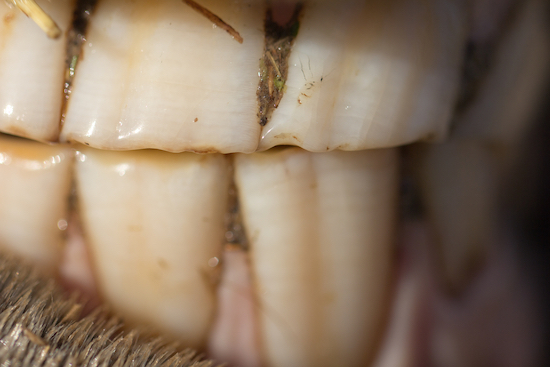
Domestic Horses Need Regular Dental Examinations
If the horse does not receive regular dental care, these issues remain unidentified until after damage has occurred. Additionally, a lack of tooth floating can cause feed to become stuck in places it wouldn’t normally.
Regular floating also helps keep the rest of your horse in prime condition. If your horse cannot chew properly, they are unable to gain nutrition from their feed. Horses with poor teeth will struggle to maintain or gain weight and muscle.
Additionally, if you ride your horse, dental issues can cause behavioral problems. These include head tossing, resistance to the bit, difficulty accepting a contact, or being hard to bridle. This is because the bit or bridle is either causing pain or making existing pain worse. Ensuring teeth are well cared for can prevent these issues.
What Happens When a Horse Gets Their Teeth Floated?
Usually, the first step in the process is to go over the horse’s history. The equine dentist may only see the horse once every 12 months, and history is important to them. Specifically, they want to know if the horse has been displaying any signs indicating there might be dental problems.
1) Sometimes Horses Sedated
What happens next depends on the individual practitioner. Some dentists sedate the horse, to keep them still and calm. This helps with a more thorough dental exam and treatment and keeps the dentist safer.
Others will not use sedation and move straight onto examination and treatment. This is more common when only minor routine work is required. In both cases, the horse will be fitted with a speculum. This is a special piece of equipment fitted to the horse’s head that holds their mouth open.
2) The Dentist Does a Dental Examination
The speculum has a headpiece that fits over the poll behind the horse’s ears. It has two metal plates, which sit between the horse’s front incisors. The speculum features a latching system, which widens the two plates and holds the horse’s mouth open.
Once the speculum is fitted and the horse’s mouth is open, the dentist will perform a thorough exam. This can involve using their hand to feel the teeth and check for sharp edges. They may also use lights and small mirrors to view all parts of the horse’s mouth and check for disease.
3) The Horses Teeth are Filed
Once the exam is complete, the dentist will begin treatment. This is where the hallmark term ‘tooth floating’ happens. The dentist may use a specially shaped hand file or power tool to file down the teeth in certain locations.
If other issues are identified, the process may be longer. This can include the extraction of damaged teeth or cleaning and treatment of abscesses or bacterial infections. These more major treatments will often require the horse to be sedated.
Final Thoughts
Wild horses float their teeth using their diet; their teeth wear down naturally due to the abrasive food they eat. Their continuous movement and foraging behavior allow them to self-regulate the care of their teeth. Because domestic horses cannot behave in this way and are fed softer foods, they require regular dental care. The equine dentist takes the place of the tough grass, bush, and bark diet of the wild horse.




